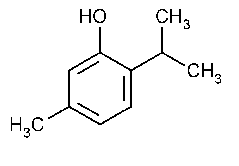Thymol
»Thymol contains not less than 99.0percent and not more than 101.0percent of C10H14O.
Packaging and storage—
Preserve in tight,light-resistant containers.
Identification—
A:
Triturate it with about an equal weight of camphor or menthol:the mixture liquefies.
B:
Dissolve a very small crystal of it in 1mLof glacial acetic acid,and add 6drops of sulfuric acid and 1drop of nitric acid:the liquid shows a deep bluish green color when viewed by reflected light.
C:
Place about 1g in a test tube,add 5mLof sodium hydroxide solution (1in 10),and heat in a water bath:a clear,colorless or pale red,solution is produced,and it becomes darker on standing,without the separation of oily drops.Add to this solution a few drops of chloroform,and agitate the mixture:a violet color is produced.
Melting range á741ñ:
between 48 and 51
and 51 ;but when melted,Thymol remains liquid at a considerably lower temperature.
;but when melted,Thymol remains liquid at a considerably lower temperature.
Limit of nonvolatile residue—
Volatilize about 2g,accurately weighed,on a steam bath,and dry at 105 to constant weight:not more than 0.05%of residue remains.
to constant weight:not more than 0.05%of residue remains.
Organic volatile impurities,Method IVá467ñ:
meets the requirements.
Assay—
Transfer about 100mg of Thymol,accurately weighed,to a 250-mLiodine flask,and dissolve in 25mLof 1Nsodium hydroxide.Add 20mLof hot dilute hydrochloric acid (1in 2),and immediately titrate with 0.1Nbromine VSto within 1to 2mLof the calculated endpoint.Warm the solution to between 70 and 80
and 80 ,add 2drops of methyl orange TS,and continue the titration slowly,swirling vigorously after each addition.When the color of the methyl orange is bleached,add 2drops of 0.1Nbromine VS,shake for 10seconds,add 1drop of methyl orange TS,and shake vigorously.If the solution is red,continue the titration,dropwise and with shaking,until the color is discharged.Repeat the alternate addition of the titrant and the methyl orange TSuntil the red color is discharged after the addition of the TS.Each mLof 0.1Nbromine is equivalent to 3.755mg of C10H14O.
,add 2drops of methyl orange TS,and continue the titration slowly,swirling vigorously after each addition.When the color of the methyl orange is bleached,add 2drops of 0.1Nbromine VS,shake for 10seconds,add 1drop of methyl orange TS,and shake vigorously.If the solution is red,continue the titration,dropwise and with shaking,until the color is discharged.Repeat the alternate addition of the titrant and the methyl orange TSuntil the red color is discharged after the addition of the TS.Each mLof 0.1Nbromine is equivalent to 3.755mg of C10H14O.
Auxiliary Information—
Staff Liaison:Catherine Sheehan,B.Sc.,Scientist
Expert Committee:(EMC)Excipients:Monograph Content
USP28–NF23Page 3098
Phone Number:1-301-816-8262
